
This website contains multiple games for kids, ranging from ELA to Math.
- Subject:
- English Language Arts
- Media Studies
- Science
- Material Type:
- Game
- Date Added:
- 03/25/2019

This website contains multiple games for kids, ranging from ELA to Math.

Through the activities within this toolkit, students will gain an understanding of the importance of nature and how all living things are connected. These resources are geared towards students in grades 6-8.

This resource examines the biodiversity and the complexity of the various life forms that make up Canadian forests. The emphasis is on helping students appreciate the relationships and interdependence of all species in this ecosystem. Students learn how they can affect forests and understand ways to preserve and maintain their diversity. Themes include biotechnology, natural and introduced pests, species at risk, habitat loss and fragmentation, protected areas, climate change and traditional indigenous knowledge. Lessons can be summarized as follows:
Lesson One- It's What Inside That Counts ( 1x90min)
Students learn the basics of biodiversity by studying the arrangements of fauna and flora in a field investigation of the schoolyard. Teams will visit three assigned "habitat" sites and record living and non-living components. After discussing results, students are asked to create a poem or story about living in one of the habitat sites.
Lesson Two- Too Hot, Too Cold,...Just Right ( 2x45min)
This lesson focuses on how climate change impacts population numbers. After a discussion on how climate changes are driven by human activity, students are guided through a role play simulating the effects of rising temperatures on Arctic, Mid-latitude and Tropical biomes. After a wrap-up with discussion questions, students are asked to write a short story on an assigned topic.
Lesson Three- What Our Elders Say (1x60min, 1x90min)
After looking at how a Canadian Aboriginal legend relates to biodiversity, the students read and perform a play based on the "Legend of The Sky Sisters". Students then write their own legend incorporating an environmental message.
Lesson Four- Barrier To Biodiversity (2x60min)
After reviewing as a class how human activity can lead to habitat loss and fragmentation, students have to write and present stories in the form of a power point presentation, poster, public service announcement or skit describing how individual plants or animals are subject to, and respond to, stress in their habitat.
Lesson Five- Off Limits (4x45min)
Students investigate officially protected areas and create a class newspaper that contains articles which focus on the role of protected areas in helping maintain diversity. In this exercise they explore the social, economic, and environmental impacts of protected areas.
Lesson Six- To Be Or Not To Be (2x60min)
Students work in groups to produce a "species at risk" game board which focuses on the habitat impacts of: change/modification, over-exploitation of resources, poorly regulated commercial harvest, disruption of migration routes/breeding behaviors, contamination, and the introduction of exotic species.
Lesson Seven- Unwelcome Guests (2 x 60min)
Students develop a "Futures Wheel"(a graphic description of the inter-relationships and impacts of a single decision or event) focusing on exotic and invasive species in Canada.
Lesson Eight- Timberland ( 1x90min)
A role playing activity is used to show how biotechnology can be used as a tool to help maintain forest biodiversity. Using a timber-theft crime story students will complete a report (including a CSI sheet and victim profile) to assist them in understanding techniques used in biotechnology.
This resource can easily be adapted to include no technology.
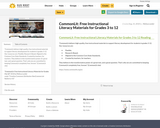
"CommonLit delivers high-quality, free instructional materials to support literacy development for students in grades 3-12. Our resources are:
Flexible;
Research-Based;
Aligned to the Common Core State Standards;
Created by teachers, for teachers.
They believe in the transformative power of a great text, and a great question. That’s why we are committed to keeping CommonLit completely free, forever." (CommonLit site)
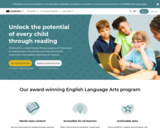
"CommonLit delivers high-quality, free instructional materials to support literacy development for students in grades 3-12. Our resources are:
Flexible;
Research-Based;
Created by teachers, for teachers.
They believe in the transformative power of a great text, and a great question. That’s why we are committed to keeping CommonLit completely free, forever." (CommonLit site)
Teachers can search for content by grade, theme, content type, genres, literary devices, and more. Alternative options are offered for students that may require adaptations for reading an easier level.
Parent guides are also provided.
Benchmark and ongoing assessments are available.
360 Curriculum provides full integrated units E.g., Unit 1 Characters Who Change and Grow which includes a baseline assessment, vocabulary activities, reading lessons, writing lessons, quiz, grammar activities, media exploration, discussion, and a culminating task.

An inquiry-based project to map the land in your community. The key concepts in this unit are grounded in Indigenous beliefs of interconnectedness, connectedness, and respect for all things.
The driving inquiry questions for this unit are:
1. How can respect for the land be shown?
2. What do we look for when setting up a camp?
3. What stories or teachings are connected to key locations in and around our community?
4. How has the land around our community changed over time?
5. Who do we share our community’s lands with?

Students in grades 4-6 engage in a series of activities (both inside and outside the classroom) designed to inspire a sense of environmental stewardship. Each of the activities is intended to have children explore their profound connection to nature and experience the power of individual and collective action.
Students explore the daily choices, they, their families, their school and their communities make; the impact of those choices on nature; and the role they and others may take in protecting nature.
The activities are fun, hands-on, and thought provoking. Students have opportunities to share what they are learning with their fellow students, family, and community and to create their own “class foundation” to collectively act on their concerns and passions.
The resource consists of 16 cross-curricular lessons on a range of issues from which teachers may select according to the dictates of their time and curriculum.
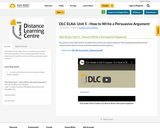
The purpose of the video lesson is to outline how to write a persuasive argument. The accompanying handout has the students go through the process of writing a good persuasive argument.
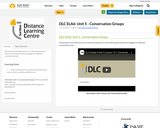
The purpose of the video lesson is to outline the purpose of conversation groups and how to engage in an effective conversation group.
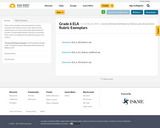
These 4 point rubric exemplars were developed to provide a consistent and common resource that aligns with the Saskatchewan curriculum and provide opportunities for transfer of responsibility between educator and student. These rubrics are designed to be edited by educator and student.

This site offers games, activities and resources in the following categories:
GAMES
MATH
LANG. ARTS
HISTORY
USA
GEOGRAPHY
SCIENCE
PEOPLE
HOLIDAYS
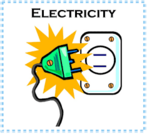
A cross-curricular project where students engage in a makerspace acitivity learning about electrical science, ELA script planning, and art!

This comprehensive website contains a great deal of information and there are many curricular connections to grades 3 – 6 Science, Social Studies, and English Language Arts.
Be sure to check out the "Past", "Evolution", "Present" and "Future" tabs along the top to access LOTS of great ag resources and information!
Among other things, the site offers:
- Simple Lessons - Depending on the sections your students study and activities undertaken, different outcomes may be met. There are several ‘grab and go’ activities for students, available in both pdf and word documents.
- Brain Buster Activities - These crossword puzzles, word searches, word scrambles, matching pages, and colouring pages are great when time is limited because they can be easily stopped and started! They will challenge students to problem-solve and test their knowledge.
- Quizzes - The quizzes here are generally the same quizzes as the students will find on the web pages. They are available for each section on this website so that students progress can be tracked if you wish!

"Kids can use this as a resource for a variety of subjects. With biographies, an atlas, and other reference materials, Factmonster is an informative place for kids to find fun facts and play educational games." (Common Sense Media)
Resources are organized across the top toolbar by subject, homework, games and tools.

Final Project- Novel study Choice board

A Fortnite or Lip Sync Battle

A complete novel study for the novel, Hatchet. This novel study includes chapter comprehension questions, video links, formative and summative assessments, choice board, rubrics, etc.

These activities for ages 11-16 explore the human impact of the climate emergency and provide new spaces, approaches and opportunities for climate education and social action.
This resource frames the climate emergency as a human rights and people-centered issue and supports teachers to promote a sense of agency and empowerment within young people.
This in turn is recognized as one strategy to help young people manage eco-anxiety, as well as disillusionment and disengagement with climate issues.
The resource includes five activities:
Activity 1 - Climate change, human rights and equality - An activity to introduce the links between climate change and human rights
Activity 2 - Climate justice - A mystery activity to demonstrate the inequalities inherent in the global interconnectedness of climate change. All people are affected in some way by the climate emergency but who you are and where you are in the world matters
Activity 3 – Critically thinking about evidence -An activity to examine case study films and make conclusions about which human rights are most threatened by climate change, which groups in society are most affected and what the solutions are.
Activity 4 – A climate consequences wheel - A consequences wheel activity using evidence from one case study film to make inferences about the different impacts of climate change on members of a community with different personal characteristics (for example: male or female).
Activity 5 – The climate game - A role play activity for which a clear space, either indoors or outdoors, is required. Learners compare the impacts of climate change on people from different backgrounds and in different circumstances. For some participants, the impacts of climate change overlap and are amplified. This strengthens learners’ understanding of intersectionality (interconnectedness).
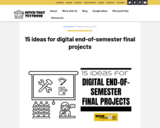
Final projects can help students summarize and review content from the entire semester. Plus, they can create fantastic products with what they've learned!
Projects let students take what they’ve learned, put it all together and show off a little of their own creativity and personality.
Options include:
1. Create a website
2. Create a screencast video
3. Make a single multimedia webpage
4. Connect with a cause
5. Create an infographic
6. Create a series of podcasts
7. Do a genius hour-style project
8. Create an annotated collection
9. Tell it as a story
10. Make an explainer video

Pobble365 helps to keep students writing. Every day, Pobble365 provides a weird, wonderful, and/or thought provoking image to spark ideas for discussions and writing. It is free and along with a different idea-inspiring image every day, Pobble365 provides a story starter, discussion questions, as well as sentence challenges and “sick sentences” to build language skills. If students don’t have online access, images and writing supports can be printed and photocopied.
The activities include a prompt, sentences stems, vocabulary bank, questions, and challenges to help you scaffold your lesson.
You will need to sign up and make an account to access the resources, but it is free to do so and each day includes a free prompt. You can also create your own!
Get your students writing every single day!